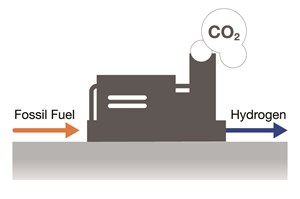News
Online Exclusive: Harnessing H2 as an eco-friendly fuel
Chuck Hayes, Global Technical Lead, Swagelok
The need for alternatives to fossil fuel production has spurred intense research into the most suitable replacement. One fuel source gaining support among environmental activists and fuel companies alike is hydrogen (H2), which can reduce or eliminate carbon dioxide (CO2) emissions. Whether H2 truly falls into the sustainable fuel category depends on how it is produced. There are three ways to achieve H2 fuel production, and each successive method is more sustainable than the last.
H2 FUEL VARIANTS AND HOW THEY ARE PRODUCED
As with generating any type of fuel, making H2 to serve as a fuel takes energy. Where the energy comes from determines how sustainable it is. Different forms of H2 fuel are designated with specific colors that reflect the energy sources used to produce it.
Gray H2. While gray H2 reduces CO2 emissions when burned, the production process may release enough CO2 emissions to offset the benefits. Steam methane reforming and coal gasification—the two processes most often used— release CO2 into the atmosphere, making it the least sustainable H2 fuel production option. Its advantage over other production methods is that it is the least expensive, making it the most common type of H2 fuel generation (FIG. 1).

Blue H2. Blue H2 also uses fossil fuels in its production; however, instead of releasing the CO2 into the atmosphere, it is captured by filters and stored. By sequestering the carbon, blue H2 is considered a low-carbon option, but it is slightly more expensive than its gray alternative (FIG. 2).

Green H2. To produce green H2, electrolysis is used to split water molecules into their component H2 and oxygen atoms. To qualify as green H2, the electricity employed must be from renewable sources like solar, wind, hydro or geothermal. In those situations, green H2 produces no CO2 emissions. As renewable energy prices continue to fall, it will become more attractive to pursue the production of green H2 vs. other forms of H2 (FIG. 3).

UNDERSTANDING THE DECLINE IN H2 FUEL COSTS
The world is reaching a tipping point where blue and green H2 make more sense to produce than their fossil fuel competitors. Major oil producers are cutting back on how much fuel they produce, raising the prices to consumers and making H2 options more attractive. Furthermore, renewable energy prices continue to come down and in some areas of the country are already cost competitive, which will reduce the costs of producing green H2. Finally, governments around the world are beginning to implement more stringent CO2 emissions standards and offering incentives to consumers who shift to more environmentally friendly forms of fuel.
Why this matters. H2 can be produced sustainably and is one of the most environmentally friendly alternatives to fossil fuels currently on the market. And despite the varying sustainability profiles of different types of H2, even gray and blue H2 minimize CO2 emissions at their point of use. Meanwhile, significant investment in green H2 is only increasing throughout the world, with industry stakeholders working to find more ways to improve production efficiencies and drive down prices for end users.

